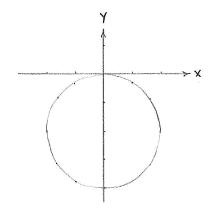Lösung 4.1:7b
Aus Online Mathematik Brückenkurs 1
(Unterschied zwischen Versionen)
K (hat „Solution 4.1:7b“ nach „Lösung 4.1:7b“ verschoben: Robot: moved page) |
|||
| Zeile 1: | Zeile 1: | ||
| - | + | Die Gleichung steht fast in der Standardform. Wir müssen nur quadratische Ergänzung für die ''y''-Terme benutzen. | |
{{Abgesetzte Formel||<math>y^2 + 4y = (y+2)^2 - 2^2\,\textrm{.}</math>}} | {{Abgesetzte Formel||<math>y^2 + 4y = (y+2)^2 - 2^2\,\textrm{.}</math>}} | ||
| - | + | Wir erhalten so die Gleichung | |
{{Abgesetzte Formel||<math>x^2 + (y+2)^2 = 4</math>}} | {{Abgesetzte Formel||<math>x^2 + (y+2)^2 = 4</math>}} | ||
| - | + | und sehen dass sie einen Kreis mit dem Mittelpunkt (0,-2) und Radius <math>\sqrt{4}=2\,</math> beschreibt. | |
<center> [[Image:4_1_7_b.gif]] </center> | <center> [[Image:4_1_7_b.gif]] </center> | ||
Version vom 18:20, 2. Apr. 2009
Die Gleichung steht fast in der Standardform. Wir müssen nur quadratische Ergänzung für die y-Terme benutzen.
| \displaystyle y^2 + 4y = (y+2)^2 - 2^2\,\textrm{.} |
Wir erhalten so die Gleichung
| \displaystyle x^2 + (y+2)^2 = 4 |
und sehen dass sie einen Kreis mit dem Mittelpunkt (0,-2) und Radius \displaystyle \sqrt{4}=2\, beschreibt.

